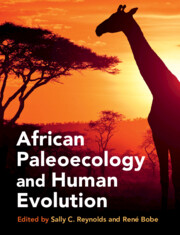Book contents
- African Paleoecology and Human Evolution
- African Paleoecology and Human Evolution
- Copyright page
- Dedication
- Contents
- Contributors
- Acknowledgments
- Part I Modern Africa and Overview of Late Cenozoic Paleoenvironments
- Part II Southern Africa
- Part III Eastern and Central Africa
- 15 Hominid Paleoenvironments in Tropical Africa from the Late Miocene to the Early Pleistocene
- 16 Mammal Paleoecology from the Late Early Pleistocene Sites of the Dandiero Basin (Eritrea), With Emphasis on the Suid Record
- 17 The 6-Million-Year Record of Ecological and Environmental Change at Gona, Afar Region, Ethiopia
- 18 The Hadar Formation, Afar Regional State, Ethiopia: Geology, Fauna, and Paleoenvironmental Reconstructions
- 19 Fossil Vertebrates and Paleoenvironments of the Pliocene Hadar Formation at Dikika, Ethiopia
- 20 Miocene to Pliocene Stratigraphy and Paleoecology of Galili, Ethiopia
- 21 Melka Kunture, Ethiopia: Early Pleistocene Faunas of the Ethiopian Highlands
- 22 Early Pleistocene Fauna and Paleoenvironments at Konso, Ethiopia
- 23 Paleontology and Geology of the Mursi Formation
- 24 Mammalian Diversity Patterns and Paleoecology in the Lower Omo Valley, Ethiopia
- 25 Paleoecology and Paleoenvironments of Early Quaternary Faunal Assemblages from the Nachukui Formation in Kenya: Insights from the West Turkana Archeological Project
- 26 Early Hominins and Paleoecology of the Koobi Fora Formation, Lake Turkana Basin, Kenya
- 27 Early Pliocene Faunal Assemblages from the Tugen Hills, Kenya: A Comparison of Field Collection Methods and Some Implications for Paleoenvironmental Reconstruction
- 28 The Southern Chemeron Formation, Tugen Hills, Kenya: A Review and a Paleoecological Analysis of the Bovid Fauna
- 29 Fauna and Paleoenvironments of the Homa Peninsula, Western Kenya
- 30 Mammalian Fauna of the Olorgesailie Basin and Southern Kenya Rift
- 31 Context and Environments of the Lower Pleistocene Hominins of Peninj, Tanzania
- 32 Paleoecology and Vertebrate Taphonomy of DK Site (Bed I), Olduvai Gorge, Tanzania
- 33 Lower Bed II Olduvai Basin, Tanzania: Wetland Sedge Taphonomy, Seasonal Pasture, and Implications for Hominin Scavenging
- 34 Paleoecology of Laetoli, Tanzania
- 35 The Paleoenvironment of the Plio-Pleistocene Chiwondo Beds of Northern Malawi
- Part IV Northern Africa
- Volume References
- Index
- Plate Section (PDF Only)
23 - Paleontology and Geology of the Mursi Formation
from Part III - Eastern and Central Africa
Published online by Cambridge University Press: 19 May 2022
- African Paleoecology and Human Evolution
- African Paleoecology and Human Evolution
- Copyright page
- Dedication
- Contents
- Contributors
- Acknowledgments
- Part I Modern Africa and Overview of Late Cenozoic Paleoenvironments
- Part II Southern Africa
- Part III Eastern and Central Africa
- 15 Hominid Paleoenvironments in Tropical Africa from the Late Miocene to the Early Pleistocene
- 16 Mammal Paleoecology from the Late Early Pleistocene Sites of the Dandiero Basin (Eritrea), With Emphasis on the Suid Record
- 17 The 6-Million-Year Record of Ecological and Environmental Change at Gona, Afar Region, Ethiopia
- 18 The Hadar Formation, Afar Regional State, Ethiopia: Geology, Fauna, and Paleoenvironmental Reconstructions
- 19 Fossil Vertebrates and Paleoenvironments of the Pliocene Hadar Formation at Dikika, Ethiopia
- 20 Miocene to Pliocene Stratigraphy and Paleoecology of Galili, Ethiopia
- 21 Melka Kunture, Ethiopia: Early Pleistocene Faunas of the Ethiopian Highlands
- 22 Early Pleistocene Fauna and Paleoenvironments at Konso, Ethiopia
- 23 Paleontology and Geology of the Mursi Formation
- 24 Mammalian Diversity Patterns and Paleoecology in the Lower Omo Valley, Ethiopia
- 25 Paleoecology and Paleoenvironments of Early Quaternary Faunal Assemblages from the Nachukui Formation in Kenya: Insights from the West Turkana Archeological Project
- 26 Early Hominins and Paleoecology of the Koobi Fora Formation, Lake Turkana Basin, Kenya
- 27 Early Pliocene Faunal Assemblages from the Tugen Hills, Kenya: A Comparison of Field Collection Methods and Some Implications for Paleoenvironmental Reconstruction
- 28 The Southern Chemeron Formation, Tugen Hills, Kenya: A Review and a Paleoecological Analysis of the Bovid Fauna
- 29 Fauna and Paleoenvironments of the Homa Peninsula, Western Kenya
- 30 Mammalian Fauna of the Olorgesailie Basin and Southern Kenya Rift
- 31 Context and Environments of the Lower Pleistocene Hominins of Peninj, Tanzania
- 32 Paleoecology and Vertebrate Taphonomy of DK Site (Bed I), Olduvai Gorge, Tanzania
- 33 Lower Bed II Olduvai Basin, Tanzania: Wetland Sedge Taphonomy, Seasonal Pasture, and Implications for Hominin Scavenging
- 34 Paleoecology of Laetoli, Tanzania
- 35 The Paleoenvironment of the Plio-Pleistocene Chiwondo Beds of Northern Malawi
- Part IV Northern Africa
- Volume References
- Index
- Plate Section (PDF Only)
Summary
The importance of the Turkana Basin (northern Kenya) and lower Omo Valley (southern Ethiopia) in our understanding of the environments in which early hominins lived, and on how climate changes may have influenced the emergence and disappearance of species, is undeniable (e.g., Bobe and Leakey, 2009; Levin et al., 2011). The majority of the Plio-Pleistocene sediments belong to the Omo Group, which consists of the Shungura, Usno, Nkalabong, and Mursi formations in Ethiopia and of the Nachukui and Koobi Fora formations in Kenya (e.g., Brown and McDougall, 2011). The Shungura, Nachukui, and Koobi Fora formations are well-studied (e.g., Howell and Coppens, 1976; de Heinzelin, 1983a, 1983b; Harris et al., 1988a, 1988b; Koobi Fora Research Project Volumes). The Mursi Formation of the lower Omo Valley, with a date of more than 4 million years, is among the oldest formations of the Omo Group in Ethiopia. However, it has been poorly documented despite its importance in informing us on the mid-Pliocene, a period in which the genus Australopithecus arose, but that is presently inadequately known. This chapter will present the formation with the history of the research in the area, including renewed fieldwork. It will be followed by a description of the geology and taphonomy and, finally, a preliminary analysis of the fauna found to date.
- Type
- Chapter
- Information
- African Paleoecology and Human Evolution , pp. 278 - 288Publisher: Cambridge University PressPrint publication year: 2022
- 1
- Cited by



